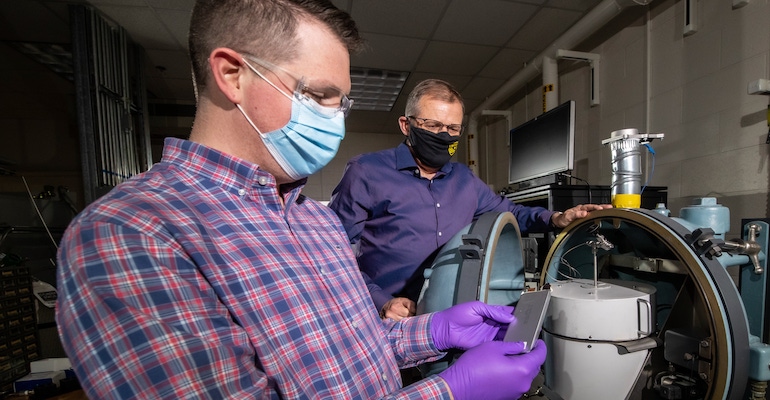Adding a Bit of Liquid to a Solid Electrolyte Doesn’t Hurt Safety
One way to move closer to solid-state electrolytes is to add some liquid electrolyte at the electrode interface—This Sandia study shows it doesn’t compromise battery safety.
March 21, 2022

Sandia National Laboratories engineers have examined lithium-based batteries in a specially designed battery testing chamber. They compared the heat released by a traditional lithium-ion battery to the heat released by a solid-state battery and a solid-state battery with a little liquid electrolyte. They found in many cases solid-state batteries with a little liquid electrolyte were safer than their lithium-ion counterparts.
One of the promises of future solid-state batteries that use solid electrolyte materials is that they will be safer than present-day lithium-ion batteries using liquid electrolytes made for highly flammable organic solvents. The liquid electrolyte allows lithium ions to easily flow from one electrode to the other during the charging and discharging of the battery. The solid electrolyte also allows the flow of lithium ions, however, the lithium has a hard time moving between the solid electrolyte and the electrodes. One solution is to add a small amount of liquid electrolyte between the cathode (positive electrode) and the solid electrolyte to facilitate the movement into the electrode material. The question that needed to be answered is whether the addition of the liquid electrolyte would make this battery less safe.
“Solid-state batteries have the potential to be safer, and they have the potential for higher energy density,” said Alex Bates, a Sandia postdoctoral researcher in a news release. “This means, for electric vehicles, you could go farther in between charges, or need fewer batteries for grid-scale energy storage. The addition of liquid electrolyte may help bridge the gap to commercialization, without sacrificing safety.”
Adding a small amount of liquid electrolyte has been proven to improve performance. “There has been a lot of controversy in the solid-state battery research community about the safety of including liquid electrolyte to ‘grease the wheels,’’’ said Yuliya Preger, a Sandia battery reliability expert. “Some scientists say that any amount of liquid electrolyte is unsafe. So, we did the calculations to see what the impacts of liquid electrolyte could be, instead of just accepting the ‘party line.’”
How Much Energy?
To figure out how safe a solid-state battery with a little liquid electrolyte would be, the research team started by calculating how much heat could be released in a lithium-ion battery, an all-solid-state battery, and solid-state batteries with varying amounts of liquid electrolyte. All batteries tested had equivalent amounts of stored energy.
“We started by determining just how much chemical energy is in the three kinds of batteries,” said John Hewson, a Sandia heat-release calculation expert on the project. “There’s only so much energy you can release, which will heat up the battery a certain amount if a chemical reaction does occur.”
In the case where a battery cell caught fire— typically from a neighboring cell—the researchers found that the solid-state battery with a little liquid electrolyte in it produced about one-fifth of the heat of a comparable lithium-ion battery, depending on how much liquid electrolyte it had. The solid-state battery without liquid electrolyte didn’t produce any heat under this scenario.
Another way batteries fail is through the formation of spikey crystals of lithium metal, called dendrites, that form on the anode during charging. A dendrite can puncture a hole through the separator that keeps the two sides apart and causes a short circuit. This is particularly a problem with batteries that have lithium metal anodes. One reason that solid electrolytes look promising is that they can suppress the growth of dendrites. In the study, all three batteries produced similar amounts of heat, which depended on how much lithium metal was in the batteries.
Something that can happen to a solid-state battery is that the solid electrolyte can break. This could happen if the battery was crushed or punctured or due to built-up pressure during operation, which would allow oxygen from one side of the battery to react with the lithium metal on the other side. In this case, the solid-state battery without liquid electrolyte could reach temperatures near that of the lithium-ion battery, a surprising result.
“One of the promises of solid-state batteries is that they are safe because the solid electrolyte is firm and unlikely to break. But if it does break, the temperature rise could be about as much as when lithium-ion batteries fail,” Preger said. “This study highlighted the importance of engineering the heck out of that separator so that it does not fail.”
“We found if the solid-state battery has lithium metal, it has the potential to be dangerous, regardless of if it has liquid electrolyte or not,” Preger said. “What we were trying to point out in this paper is that there’s a definite trade-off between performance and safety but adding a bit of liquid may greatly increase performance while only having a small impact on safety.”
Understanding this trade-off may help speed up commercialization, researcher Loraine Torres-Castro added. “Having the clarity and the confidence that knowing a small amount of liquid electrolyte will not create huge safety issues may help the development of commercial solid-state batteries. Adding liquid electrolyte could fix one of their main problems, the solid electrolyte interface.”
Kevin Clemens is a Senior Editor with Battery Technology.
About the Author(s)
You May Also Like





